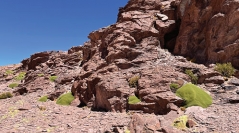

 European Journal of Taxonomy
1012 (222) - Pages 222-238
European Journal of Taxonomy
1012 (222) - Pages 222-238Despite being the driest desert on earth, some areas of the Atacama receive precipitation and harbour a diverse fauna and flora. Two new nematode species are described from the more humid regions of the Atacama Desert. Cervidellus hueckeswagensis sp. nov. was discovered in several high-altitude locations along the west slopes of the Andes. It is most similar to C. caucetensis and C. vinciguerrae in the shape of the labial probolae and to C. bifidihastatus, C. hamatus, C. doorsselaeri and C. capraeolus in the shape of the cephalic probolae, being uniquely characterised by having asymmetrically triangular lips with 6–7 tines and bifurcated labial probolae without additional tines or swellings. Stegelleta waltrautae sp. nov. was found in the coastal sand dunes. It is most similar to S. tuarua in having a large number of longitudinal lines and lateral alae with five incisures but differing in the shape of the cephalic probolae and distinctly protruding vulva.
Atacama, Cervidellus, Stegelleta, morphology, taxonomy